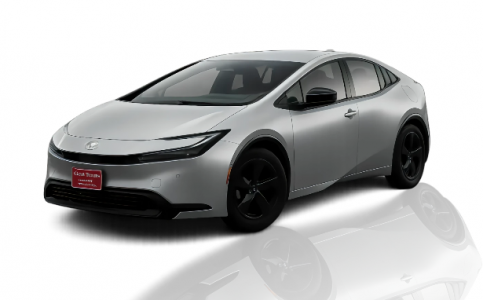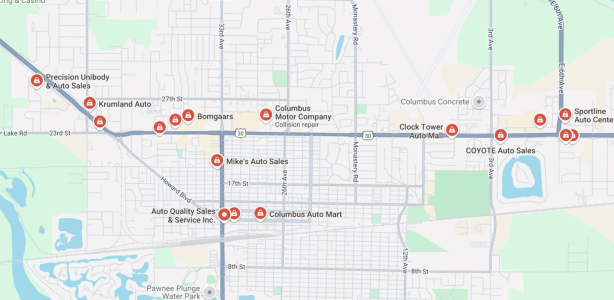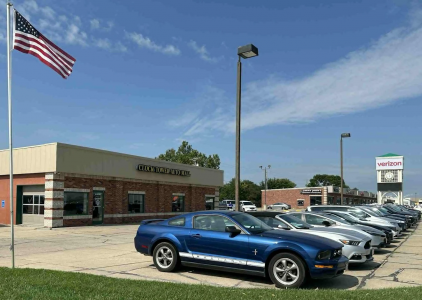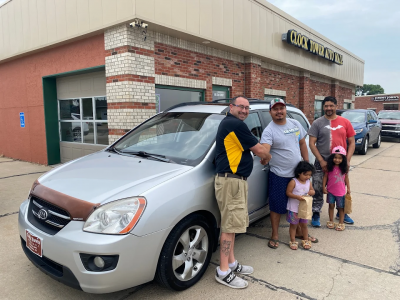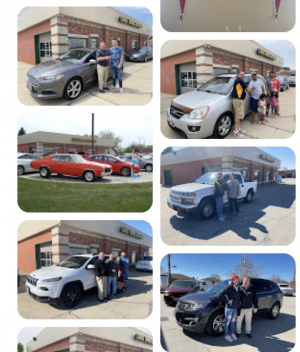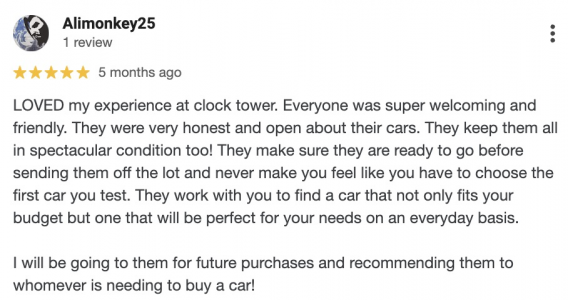- May 1, 2009
- 87
- 97
- Awards
- 4
- First Name
- Greg
ok - so let's look at it this way (hope you realize I'm trying to be helpful and not trying to argue...)
TLDR: Not saying speed doesn't matter - but there are a TON of other things that matter a lot more. Ultimately, it's about demand in your local market. You can only get as many leads as there are people looking to buy cars - and specifically, the cars you're selling. I could even argue that your site doesn't matter, and success is more tied to the inventory you carry... But let's say there are 10 dealerships in your market, and all of them have a 4 to 5 second load time. Assuming everyone's selling basically the same inventory, if you were to get your load speed down to 3 seconds, it wouldn't matter AT ALL for ranking in Google, and it likely wouldn't matter in any measurable way how many leads you get or cars you sell.
But - in the same scenario - if every other dealer site in town took 8-9 seconds to load and yours takes 3, then yeah, that's enough of a difference that it'll get you more conversions, even if it doesn't matter for ranking in Google.
AND - most importantly... In that same scenario, if everyone else was 8-9 seconds of load time but you're 3, but everyone else has stellar content and is actively doing SEO and you're not, then the speed won't matter, cause you won't show up on page 1 of search results so no one will find you...
Google has confirmed that speed was a ranking signal SPECIFICALLY because they knew SEOs would go out and make sites faster. So now it takes less time for Google to crawl sites, which saves them TONS of money. Is it better for users? sure. But the REAL reason Google said that was to get SEOs to change the ecosystem so they could make more money.
also, as i've already stated, Google only uses page speed as a ranking factor to demote you if you're in the bottom 20-ish percent. I have heard this personally from Google engineers.
Also - don't misinterpret Google. CWVs were added into the algorithm, but that doesn't mean they're a ranking signal (as in, doing one element better means you rank better). it's taken into account and you're penalized if you suck, but it's been proven that your CVW scores do no correlate to better rankings...
Same thing with lighthouse - again, it's not a "here's a tool to help you rank better" situation. It's google giving you a tool that ultimately just makes it cheaper for Google to crawl sites. Sure, the usability stuff is important, but it's important for conversions, and to a small degree, ranking. But a few tenths of a point difference - or even a full point or two difference - in CVW scores does not mean you'll rank better.
And - be sure you understand your metrics. I actually want a site to have a high bounce rate and low time on site. That means the customer found what they want and converted quickly and didn't have to click around to a bunch of pages to get their answer.
So basically, all I'm saying is that there are hundreds of factors that influence your visibility in search results, and lots of factors that influence conversion. Site speed is a REALLY small factor on both sides. As a dealership, as long as your site is USABLE within a second and total load time is under 6-8 seconds, you're good on site speed and you have a LOT of other more influential things you should be worrying about.
And yes - I've been doing SEO for almost 20 years for car dealers, so this is from personal experience and testing. Plus, I speak at SEO conferences all over the world, so I know most of the top minds, and have had discussons on this sort of thing ad nauseum.
and there is no "if the site DOES get indexed" - it *IS* indexed already... I'm not overstating the risk, I'm just letting you know it's VERY bad to get indexed on a dev subdomain before the site goes live. Again, I know this from personal experience and testing (and because I know how Google works).
Look - again, I don't want to argue. But It has been proven time and again that people don't use footer nav (except on sites with bad UX design). And Google has stated that footer nav links are a spam signal. and Google flat out tells you in the QR Guidelines that it's important to have certain pages in your menu.
I know for a fact that if someone wants to contact you and the only way they can do it is to find a contact link in the footer, you'll lose a SIGNIFICANT number of conversions... your entire argument about site speed revolved around losing conversions if you're slow or gaining them if you're fast... noe of that even compares to the number of conversions you'll lose by only having the contact link in the footer.
In general - you should think more about what makes the site better for customers and rely less on trying to use a handful of stats that you like to target...
Those aren't local business websites. you simply cannot use ANY of those to make this argument. Half of these are not sites that people would need to contact anyway. Come on, you can't say you're doing something a certain way because a social media site does it that way...
If you build an element of your site (like the blog) that's only there for Google and no human users can get to it, then Google won't care. Ultimately, it seems like you're wanting to make an awesome site that performs well with humans and ranks well in Google results. That's awesome, and most dealers don't think through things this thoroughly... but a statement like
-----The blog is built for external discovery through search engines and backlinks.
is outdated and incorrect. If you're putting up a blog post just to get links and to show in search results, then you're not putting up a blog post to help your customers. If it's not helping humans, it won't help with Google either.
that's from a sample list that includes TONS of sites. you can't compare informational sites to transactional sites, or local brick-and-mortar sites to e-commerce. If someone is going to an informational site and nothing loads in 3 seconds, then sure, people bail. But this study is specifically about what's rendered. If you get content rendered in a tenth of a second, but some element on the page takes 5 seconds to load, your page load time is 5 seconds, but it's usuable in less than a second. So if a dealership site takes 5 seconds to load but has content on the screen after less than a second, that's not at all what this metric means...
- Google found that 53% of visits are abandoned if a site takes more than 3 seconds to load.
Totally valid because it's only dealership sites. but yeah, obviously this is going to play out this way. anything over 4-5 seconds falls in the lower end of the load speed window, and going all the way to 8s likely touches at least part of the bottom 20%. Fixing that means better user experience and no demotion from Google. But notice their "final" nubmer is still nearly 4 seconds.
- SurgeMetrix and Cox Automotive crawled 9,800 dealership websites and found that cutting load time from 8s to 3.8s increased sessions by 1,000/month and added 30+ leads/month.
assuming this is an automotive study, but i haven't heard of it. Regardless, without more details about the methodology here, this means nothing. This is just like the Amazon study, it doesn't really mean anything. Even if it's only dealership sites, are they looking at the site as a whole? Just VDPs? Just forms? Informational pages or transactional pages?
- AutoJini reported that a 1s delay reduces conversions by 7%.
Who said this though? Was it just published there by someone who did the research, or was it their team? I can tell you it doesn't matter though, this is a garbage metric. Google Lighthouse is a code assitant tool, not a tool from Google that says "if you get a better score you rank better or convert better". Could it drive 30 more leads? Sure, on a big site. But a small used car dealership in a small market might only have enough local customer interest to get a total of 30 leads per month. you could go optimize and get a better score - and you'd still only get 30 leads per month.
- Dealer Marketing Magazine says simply optimizing for Google Lighthouse can drive 30 more organic leads/month.
Same thing here - without context, it's BS. If your market demand only supports 150 leads monthly, reducing load time doesn't mean you magically get another 200 form fills. In this case, they're talking about the load time of the form, not of the home page... because there is no form on a home page.
- AutoSweet said reducing load time from 4s to 2s led to 200 extra form fills/month.
TLDR: Not saying speed doesn't matter - but there are a TON of other things that matter a lot more. Ultimately, it's about demand in your local market. You can only get as many leads as there are people looking to buy cars - and specifically, the cars you're selling. I could even argue that your site doesn't matter, and success is more tied to the inventory you carry... But let's say there are 10 dealerships in your market, and all of them have a 4 to 5 second load time. Assuming everyone's selling basically the same inventory, if you were to get your load speed down to 3 seconds, it wouldn't matter AT ALL for ranking in Google, and it likely wouldn't matter in any measurable way how many leads you get or cars you sell.
But - in the same scenario - if every other dealer site in town took 8-9 seconds to load and yours takes 3, then yeah, that's enough of a difference that it'll get you more conversions, even if it doesn't matter for ranking in Google.
AND - most importantly... In that same scenario, if everyone else was 8-9 seconds of load time but you're 3, but everyone else has stellar content and is actively doing SEO and you're not, then the speed won't matter, cause you won't show up on page 1 of search results so no one will find you...
Google has confirmed that speed was a ranking signal SPECIFICALLY because they knew SEOs would go out and make sites faster. So now it takes less time for Google to crawl sites, which saves them TONS of money. Is it better for users? sure. But the REAL reason Google said that was to get SEOs to change the ecosystem so they could make more money.
also, as i've already stated, Google only uses page speed as a ranking factor to demote you if you're in the bottom 20-ish percent. I have heard this personally from Google engineers.
Also - don't misinterpret Google. CWVs were added into the algorithm, but that doesn't mean they're a ranking signal (as in, doing one element better means you rank better). it's taken into account and you're penalized if you suck, but it's been proven that your CVW scores do no correlate to better rankings...
Same thing with lighthouse - again, it's not a "here's a tool to help you rank better" situation. It's google giving you a tool that ultimately just makes it cheaper for Google to crawl sites. Sure, the usability stuff is important, but it's important for conversions, and to a small degree, ranking. But a few tenths of a point difference - or even a full point or two difference - in CVW scores does not mean you'll rank better.
And - be sure you understand your metrics. I actually want a site to have a high bounce rate and low time on site. That means the customer found what they want and converted quickly and didn't have to click around to a bunch of pages to get their answer.
you can ignore anything about crawl budget or crawl rate. Dealership sites are nowhere near big enough for this to matter. Until you have hundreds of thousands of unique pages on your site, this isn't something that applies to you
- Google has a crawl budget and crawl rate, and slower-loading sites (especially those with poor First Contentful Paint or Largest Contentful Paint scores) can end up with fewer pages indexed, even for smaller sites.
Sure, if we look at all sites combined. But dealer sites are image-heavy by nature, which means they load slower. There is simply ZERO chance that any customer out there is running a timer and bails if a site takes 3 seconds to load instead of 2. Because again, we're not talking time for the page to be usable, we're talking until every server call is completed and the page is fully rendred in the browser.
- Session drop-off rates increase sharply with every additional second it takes for a page to load, especially on mobile.
out of context, that seems awesome. But they also reorganized the menu and site structure and did a crap ton of SEO. So it wasn't a big increase ONLY because they made it faster.When you add that up plus data from companies like Koons Automotive reporting a 1,400% increase in conversions simply by speeding up their site, I just don’t see how speed isn’t at the top of the list.
So basically, all I'm saying is that there are hundreds of factors that influence your visibility in search results, and lots of factors that influence conversion. Site speed is a REALLY small factor on both sides. As a dealership, as long as your site is USABLE within a second and total load time is under 6-8 seconds, you're good on site speed and you have a LOT of other more influential things you should be worrying about.
And yes - I've been doing SEO for almost 20 years for car dealers, so this is from personal experience and testing. Plus, I speak at SEO conferences all over the world, so I know most of the top minds, and have had discussons on this sort of thing ad nauseum.
Not correct - Google NEVER said that if you get good scores on Lighthouse, you rank better...And the arbitrary tool is Google's tool, that they say they use for ranking!
Actually, it doesn't depend on context. The lack of canonicals and the indexation of your site before it's live at that URL will DEFINITELY cause you problems you wouldn't have had otherwise if they had been responsible and kept the dev version from being indexed. Google can see the content, but it's associated with their site, not yours. And you DO have duplicate content issues because you don't have a canonical declaration set up in the site code. And links aren't required for indexation or ranking.I hear you and I agree that in many cases, you want to avoid indexing a development site. But I think it depends entirely on the context, and it’s not always “extremely bad.”
and there is no "if the site DOES get indexed" - it *IS* indexed already... I'm not overstating the risk, I'm just letting you know it's VERY bad to get indexed on a dev subdomain before the site goes live. Again, I know this from personal experience and testing (and because I know how Google works).
Bro... I never said to ignore it, i just said it doesn't matter if your site is loading fast enough. SEO - and Google's algorithm - are FAR more complicated than that...I definitely see what you’re saying. And I agree that Amazon and Google operate at a different scale than a single-location dealership.When Google, Amazon, Walmart, and CDK publish detailed studies showing how even small gains in speed impact conversions, bounce rates, crawl budgets, and revenue, I think it’s worth paying attention.
Yeah, but Google/Amazon/Walmart are MASSIVE sites with millions of pages. Car dealership sites are a completely different animal. If amazon says a 1/2 second of saved load time = 20% more conversions, that ONLY applies to Amazon, not to every site online... that's what i meant when I said those metrics were garbage (not that site speed is garbage)
That said, the reason I lean on those examples is because they’ve tested this stuff at the deepest levels and the principles apply even if the exact percentages don’t translate one-to-one. And it’s not just them:
So while Amazon’s scale is different, the underlying concept of faster pages reduce friction, increase engagement, and drive more conversions seems to be absolutely true for dealership sites.
- Google found that 53% of visits are abandoned if a site takes more than 3 seconds to load.
- SurgeMetrix and Cox Automotive crawled 9,800 dealership websites and found that cutting load time from 8s to 3.8s increased sessions by 1,000/month and added 30+ leads/month.
- AutoJini reported that a 1s delay reduces conversions by 7%.
- Dealer Marketing Magazine says simply optimizing for Google Lighthouse can drive 30 more organic leads/month.
- AutoSweet said reducing load time from 4s to 2s led to 200 extra form fills/month.
Also, Google has confirmed that speed is a direct ranking signal for mobile and desktop, and Core Web Vitals (LCP, FID, CLS) are all part of the algorithm. I’ve personally seen local businesses improve rankings significantly after passing these metrics.
And I’m not obsessing over a score for vanity, I’m optimizing for better indexing, smoother UX, and more engagement. Because as Google, Cox Automotive, and multiple case studies show: speed influences visibility, leads, and sales and that’s too important to ignore.
I completely agree that user experience is critical in fact, I’d say page speed is user experience.and again - speed doesn't influence ranking UNLESS you're in about the bottom 20% of sites in your vertical... and speed doesn't influence crawl rate on a site as small as a dealership. and it won't affect bounce rate unless it's really bad (and bounce rate is a garbage metric anyway). It *IS* important for user experience - so instead of concentrating on coding to achieve a good score on an arbitrary tool that means nothing, concentrate on the user experience. That's all I'm saying...
If Google says Core Web Vitals are direct ranking signals, and gives us a tool like Lighthouse to measure them, it’s hard for me to see how optimizing for those metrics isn’t in the best interest of the client.
And it's not just about a score it's about what that score reflects:
When you add that up plus data from companies like Koons Automotive reporting a 1,400% increase in conversions simply by speeding up their site, I just don’t see how speed isn’t at the top of the list.
- Page load speed affects bounce rate and session duration, both of which feed into Google's engagement signals.
- Google has a crawl budget and crawl rate, and slower-loading sites (especially those with poor First Contentful Paint or Largest Contentful Paint scores) can end up with fewer pages indexed, even for smaller sites.
- Session drop-off rates increase sharply with every additional second it takes for a page to load, especially on mobile.
I totally get that not every stat applies equally across the board, but to me, unless we’ve tested it ourselves and proven it false, it seems smart to give the dealership every advantage we can starting with what Google and industry leaders are telling us speed matters most.
Out of curiosity have you run any A/B tests or speed studies on dealership sites to see how it plays out?
And the arbitrary tool is Google's tool, that they say they use for ranking!
I hear you and I agree that in many cases, you want to avoid indexing a development site. But I think it depends entirely on the context, and it’s not always “extremely bad.”It's EXTREMELY bad for SEO for your site to get indexed if it's "in development" - I saw at least one person point this out already, it's going to cause all kinds of problems that you're getting indexed when you're not "live" yet - so get your provider to fix that... (any provider should know this, it's a bit scary that they don't)
Here’s how I’m thinking about it:
That said, I’m still planning to put noindex in place!
- There’s no duplicate content issue, because this domain hasn’t been used before and doesn’t share content with the current live site.
- There are no inbound links yet, so it’s not going to outrank or interfere with the primary site in Google’s results.
- If the site does get indexed, and we later 301 redirect it to the main domain, we’d retain any equity (if there even is any by then) and consolidate that into the live site, which can actually help from an SEO standpoint.
- All the contact info routes to the real business, so there’s no user experience or brand confusion.
What worries me more is the idea of ignoring page speed or Core Web Vitals when we know those affect visibility, crawlability, user experience, and conversions and we’ve got hard data from Google, Amazon, and the auto industry backing that up.
Look - again, I don't want to argue. But It has been proven time and again that people don't use footer nav (except on sites with bad UX design). And Google has stated that footer nav links are a spam signal. and Google flat out tells you in the QR Guidelines that it's important to have certain pages in your menu.
I know for a fact that if someone wants to contact you and the only way they can do it is to find a contact link in the footer, you'll lose a SIGNIFICANT number of conversions... your entire argument about site speed revolved around losing conversions if you're slow or gaining them if you're fast... noe of that even compares to the number of conversions you'll lose by only having the contact link in the footer.
In general - you should think more about what makes the site better for customers and rely less on trying to use a handful of stats that you like to target...
In fact, the biggest and most trusted websites in the world including but not limited to:
… don’t put ‘About Us’ or ‘Contact’ in their main nav. They all put that information in the footer.
- Amazon
- Walmart
- YouTube
- Netflix
- TikTok
Those aren't local business websites. you simply cannot use ANY of those to make this argument. Half of these are not sites that people would need to contact anyway. Come on, you can't say you're doing something a certain way because a social media site does it that way...
If you build an element of your site (like the blog) that's only there for Google and no human users can get to it, then Google won't care. Ultimately, it seems like you're wanting to make an awesome site that performs well with humans and ranks well in Google results. That's awesome, and most dealers don't think through things this thoroughly... but a statement like
-----The blog is built for external discovery through search engines and backlinks.
is outdated and incorrect. If you're putting up a blog post just to get links and to show in search results, then you're not putting up a blog post to help your customers. If it's not helping humans, it won't help with Google either.







